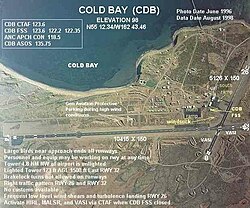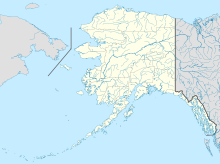Cold Bay Airport | |||||||||||||||
|---|---|---|---|---|---|---|---|---|---|---|---|---|---|---|---|
 | |||||||||||||||
| Summary | |||||||||||||||
| Airport type | Public | ||||||||||||||
| Owner | State of Alaska DOT&PF - Central Region | ||||||||||||||
| Serves | Cold Bay, Alaska | ||||||||||||||
| Elevation AMSL | 101 ft / 31 m | ||||||||||||||
| Coordinates | 55°12′19″N 162°43′28″W / 55.20528°N 162.72444°W | ||||||||||||||
| Map | |||||||||||||||
 | |||||||||||||||
| Runways | |||||||||||||||
| |||||||||||||||
| Statistics (2016) | |||||||||||||||
| |||||||||||||||

Cold Bay Airport (IATA: CDB, ICAO: PACD, FAA LID: CDB) is a state owned, public use airport located in Cold Bay,[1] a city in the Aleutians East Borough of the U.S. state of Alaska. First built as a United States Army Air Forces airfield during World War II, it is one of the main airports serving the Alaska Peninsula. Scheduled passenger service is available and air taxi operators fly in and out of the airport daily. Formerly, the airport operated as Thornbrough Air Force Base.
According to Federal Aviation Administration (FAA) records, the airport had 9,105 passenger boardings (enplanements) in calendar year 2008,[2] 8,968 enplanements in 2009, and 9,261 in 2010.[3] It is included in the National Plan of Integrated Airport Systems for 2011–2015, which categorized it as a "non-primary commercial service" airport, meaning it has between 2,500 and 10,000 enplanements per year.[4]
Cold Bay's main runway is the fifth-largest in Alaska and was built during World War II. Today, it is used for scheduled cargo flights by Alaska Central Express and is sometimes used as an emergency diversion airport for passenger flights crossing the Pacific Ocean.[5][6]
A myth describes Cold Bay Airport as an alternate landing site for Space Shuttles,[7] but the National Aeronautics and Space Administration (NASA) has stated that it was never so designated, and it was not within the entry crossrange capability of Space Shuttles.
There is a National Weather Service (NWS) office (which sends up radiosonde balloons twice a day) colocated with the FAA Flight Service Station at the airport. The NWS ranks Cold Bay as the cloudiest city in the United States.[8]
- ^ a b FAA Airport Form 5010 for CDB PDF. Federal Aviation Administration. effective April 27, 2017.
- ^ "Passenger Boarding (Enplanement) and All-Cargo Data for U.S. Airports" (PDF, 1.0 MB). Federal Aviation Administration. December 18, 2009.
- ^ "CY 2010 Passenger Boarding and All-Cargo Data" (PDF, 189 KB). Federal Aviation Administration. October 4, 2011.
- ^ "2011–2015 National Plan of Integrated Airport Systems, Appendix A" (PDF). Federal Aviation Administration. October 4, 2010. Archived from the original (PDF, 2.03 MB) on 2012-09-27.
- ^ "Continental trans-Pacific flight makes emergency landing". The Associated Press. 2004-10-19. Archived from the original on 2011-05-24. Alt URL
- ^ "A Quick Fix—Getting a 787 Back in the Air After a Diversion". Flightradar24. 2016-10-22.
- ^ Rowe, Mike, 1962- (15 October 2019). The way I heard it. Hall, Marcellus (First Gallery Books hardcover ed.). New York. ISBN 978-1-982130-85-5. OCLC 732767658.
{{cite book}}: CS1 maint: location missing publisher (link) CS1 maint: multiple names: authors list (link) CS1 maint: numeric names: authors list (link) - ^ Osborn, Liz. "Cloudiest Places in United States". Current Results weather and science facts. Current Results Nexus. Retrieved 10 September 2015.
